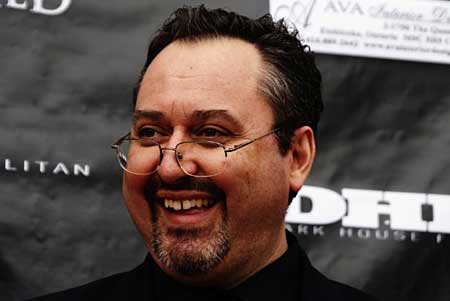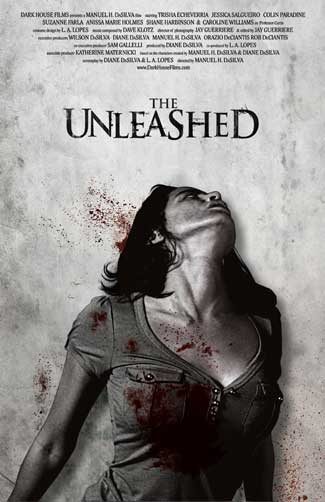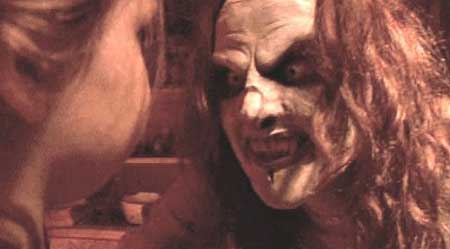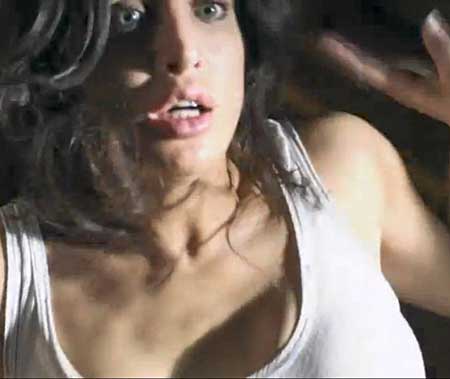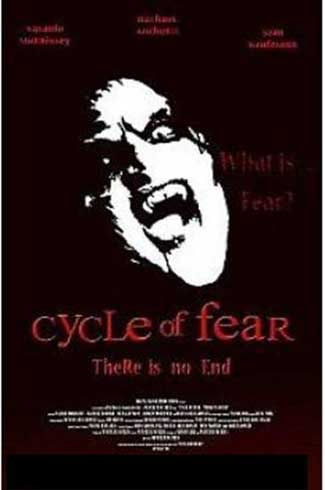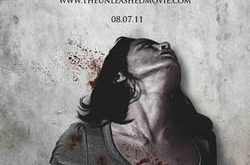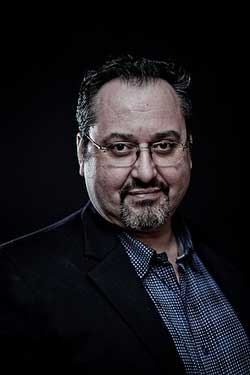 UNLEASHING MANUEL H DASILVA
UNLEASHING MANUEL H DASILVA
Perhaps this year’s most anticipated screening at the annual Canadian Film Fest was Dark House Film’s The Unleashed Mere hours before the festivities commenced I spoke with Manuel Da Silva from his studio on a myriad of topics ranging from the origins of the Ouija board, the future of independent genre films and what makes a truly spine tingling movie experience.
DAVE GAMMON: A warm welcome Mr. Da Silva to Horrornews.net. I wish to discuss The Unleashed which of course is all the buzz of the Canadian Film Fest to be screened here this coming Friday. As director of a prior film Cycle of Fear how has that experience transcended into the making of The Unleashed?
MANUEL H DASILVA: Cycle of Fear was an interesting project; only because it was one of those projects that had so many problems with it. We never really anticipated that we were ever going to complete it. I was determined to complete it regardless. When we did Cycle of Fear not only it showed how determined I was but also it opened the doors to The Unleashed. Let’s be honest if you can’t finish your last film why would anybody want to fund your next film?
DG: A good point, sure.
MD: So I did whatever I could. I learned so much on that film. It’s not a very good film But it’s finished and I’m glad that I did. I’m always going to say that I’m proud of that experience and everything else because it got me where I am. You have to look at every film in a positive way in order to move ahead.
DG: Absolutely. I couldn’t agree more. I think you’ll find in the horror genre there’s pretty much a need for every market really.
MD: It’s an exciting genre, let’s be honest.
DG: Sure, sure (laughs)
MD: It’s very exciting. You can do a drama. People are always so tense when you do a drama film. When you do a horror it loosens up the crew, the cast are smiling. They’re giggling at blood being thrown up in the air. The atmosphere is total electricity.
DG: Just a lot of good, primal fun. Tell us about The Unleashed and how does it differ from other ghost or demonic possession films of today?
MD: The Unleashed is actually a lot different. Besides the fact it’s based on the Ouija board which we fabricated and stated that it was actually created a hundred years ago. So we actually went with our own version of the Ouija board. What I like to think is different about The Unleashed is there’s a real fantastic story of an individual with not only psychological problems with her family and her childhood and most people suppress them, try to move on yet they haunt them. She has to face them in regards to the unknown and the spirits and enlightening stuff that people love about horror and thrillers.
Another thing that I tried to do differently is not to highlight the gore and blood. I focused on the traditional scares and suspense. Film makers like John Carpenter, I always enjoyed how he created a real sense of suspense. All the sudden you bump into something I like to call stings. It scares the audience and I was always a big fan of that.
DG: I always admired the rising tension. It’s effective horror really.
MD: I agree with you, I do. There was a day, the day we shot the séance scene in the film and it was on Friday the 13th in August of 2010. People, agents and parents were calling me, ‘please don’t shoot today. It’s bad luck.’
Friday the 13th? Thirteen is actually good luck in some cultures. I said I’m going to shoot this. I just kept on going. Everything was fine at the end of the day. That was one of the things you had to deal with. Another incident was our red camera broke down and we had to replace that.
DG: What were some of the biggest obstacles when translating this vision of horror onto the big screen?
MD: The hardest thing to translate from script visually on film is the fact that the characters are multi-layered. I mean they go through levels if you will; emotions throughout the film. It’s very hard to keep emotions consistent when you’re shooting scenes out of order.
That was a huge challenge because if that didn’t’ work, if the performances weren’t up to par, their emotion level we had to face or deal with in order to execute the character in that particular scene. It could’ve been a huge problem throughout the film.
And then I enhanced that a little bit more with visual effects on screen. I did a little bit of green screen before but not in this film. A lot of things I like to tell people is when they say ‘I didn’t see a lot of visual effects in the film’ that’s good because there were special effects added in there that could be as simple as a refrigerator that we added in there. If you can’t tell if that’s a special effect then we did our job.
DG; Sure subtlety is a good thing in this case right?
MD: Absolutely, absolutely. I don’t know if I answered your question but I hope I did (combined laughs).
DG: How does the Ouija board become a symbol synonymous with effective horror?
MD: I think there is a lot of fear about the Ouija board. People like to play the Ouija board. There are those who are hesitant and those who believe. I like that. We have the skeptics in the film, we have those who are believers and we have those who are laughing and saying oh this isn’t true. The Ouija board itself, people are always afraid, what if something comes through? Even if they don’t want to believe it, what if it does? That’s the most terrifying thing.
DG: The suspended belief, the what if factor for sure.
MD: What if? What if? Some people don’t want to believe. I don’t believe but I don’t want to play it anyhow. Okay what if I play it and I do see something? One thing that I noticed about horror films and I absolutely love and with the Ouija board I think we touched on some really touchy subjects such as the afterlife and whether or not you make that decision to stay as a ghost or not. But for the simple fact that when you deal with this kind of phenomenon and the unknown it’s such a big trip and it fuels fear. What is in the after life? Is something going to come through? Is something going to follow us home? It all comes out with our own insecurities as individuals.
DG: It preys upon them and exploits them a thousand fold I’d have to say.
MD: I’ve never played with one. But my family members have. Actually one of them played with a Ouija board in a cemetery.
DG: Wow (combined laughs)
I find the whole concept riveting. I remember as young kids we had one too. It definitely stirred some emotion and stirred some suspended belief as well.
MD: Can I ask you something Dave? When you play with a Ouija board do….okay this is how my sister explained it to me. It’s more about wanting to see….something as opposed to wanting something to come out and terrorize you. You want to see if something is there. Is that why you played it? Were you hoping to see something?
DG: Oh, it was a curiosity for sure. It was trying to reach out and contact a lost loved one or a family member, friends whatever the case may be. It was definitely a curiosity.
MD: And everyone has different reasons too. It’s a fascinating subject.
DG: Definitely and I think it’s going to do really well. Is there a specific demographic The Unleashed will appeal to? Is there a wider audience in favor of contemporary horror today?
MD: I’m going to say yes. I really do believe there is a wider audience. I think a lot of people connect with the Ouija board even at my age group and due to the fact it was exploited in 1972 when Reagan played with the Ouija board before she’d become possessed in the Exorcist. So there’s always been that interest. So I think it translates into that. I think a lot of films have covered the Ouija board but none have really made it their focal point and who stole it. We exploit that in our film. I like that. That’s one of the reasons we did the film. It explains how it was made and its origins.
The younger generation will follow along and I’m really glad because there’s that interest and that curiosity. I like to think it comes from the older generation maybe they’ve shown them some of these films. There’s a natural curiosity this day in age. I’ve researched a fair amount about it. People are fascinated by it.
DG: I don’t think it’s unusual at all now to see parents going to films such as this with their teenage kids.
MD: With our film we’d gotten a 14 AA rating so that’s fantastic.
DG: So it’s not unusual at all to see second, third generations interested in this synonymously. It’s encouraging to see.
MD: One thing I want to throw in there too. We don’t pick sides. We have our own ideas, own stories. It’ll always be up for debate. We realize that when we did the film. We’re not trying to convince you to believe it. We’re not trying to convince you not to believe it.
DG: -Which makes for a conversational piece long after the fact. I think that achieves the purpose for any film in its longevity too.
MD: Agreed, agreed.
DG: Who were some of your director influences? You’d mentioned John Carpenter earlier any other influences when you’d first gotten into the industry?
MD: Yeah believe it or not when people ask me what’s your favorite director, your favorite horror, things like that I say John Carpenter. But Martin Scorcese is one of my favorite directors. He doesn’t do horror films, not as far as I know anyway. But John Carpenter was the biggest motivation for this kind of film. The reason is simply because of the suspense build up. You know it’s tricky because you can like Halloween. You can love the things that they do. But you can’t repeat what they do because it’s original.
DG: That’s true.
MD: You have to come up with a style that is similar to maintain the integrity of the scare. What I mean by that is you don’t want to go and do something like opening up a window and throwing a pail of blood at somebody. It will scare you but I’m not a big fan of that kind of scare or suspense build up. John Carpenter-You’ve seen Halloween. It’s nicely done. I think it’s not just the music, but the camera work and the mood those are the ingredients. I like that. You don’t see a lot of blood in that movie as well which is one of the things you won’t see in my film is too much blood.
DG: No and I think the rising conflict in the Carpenter films can be attributed often to what you don’t’ see, the anticipation factor too.
MD: And I love that. You know I’ll give you another example have you seen Paranormal Activity 3?
DG: I haven’t seen the third one. I’ve seen the first two though.
MD: Alright the third one had some really good scares in there. They did what we just talked about as far as techniques used in filming. I thought that if something’s not there, something’s there…..every audience member….that’s the beauty of this type of genre; if we show them what’s coming up, some of them get scared some of them don’t’s like what you were saying Dave if you don’t show what is the unknown we have to overcome the fear that we’re feeling. That fear intensifies and the beauty of that is, since we’re not showing it everyone has a different interpretation of what scares them, that’s what’s going to scare everyone together. But if you just put one thing, a man in a costume all of the sudden some people will be afraid of that while others will be thinking well that doesn’t scare me at all. We just told them what to be afraid of.
DG: Who are some of the silver screen directors of today who have caused you to sit up and notice?
MD: You know I’d have to really say I like James Wan. He did the movie Insidious. I really, really, really liked that film. Another director- have you ever heard of Guillermo Del Toro? He did it a terrific horror film, an intelligent horror film, that along with the director also did something called the Devil’s Backbone, The Orphanage. They’re all foreign films but they scare you. They have terrific stories. They have a message in each story. Those are the kind of horror films I want to make.
DG: I find a lot of adaptations too whether it be through Italian films, or Japanese films they know how to scare their western audience for sure.
MD: Agreed, agreed. Some good examples of that would have to be The Ring and The Grudge. Both correct me if I’m wrong were Japanese films before they came into our market.
DG: Definitely. The Ring still kind of gives me the creeps to this day. (combined laughs).
MD: Needless to say we all know what scene stands out the most in that film.
DG: Oh yeah….
MD: The girl coming out of …..
DG & MD:…..the TV.
DG: And you know even though it’s been parodied in a dozen other films it still preys on the subconscious.
MD: And it works. The sequel didn’t do as good but that’s another topic I guess.
DG: What are your views on increasing technological trends for today’s typical movie goer? Where do you see the direction taking from an evolution perspective?
MD: I think it’s a double edged sword. The reason I say that is because in the pro’s category it’s getting easier to get access to cameras and one of the biggest issues I have is cam owners that want to go out and make a movie, not learn how to make it, who you need to make it, and spend all this money on just trying to do something. Because the technology is there most people are doing that. Why they don’t succeed is because they just have a very basic idea on how to do that. The amount of technology that is thrown at us and the quality of work accessible to new film makers is over whelming. Back in the 90’s you couldn’t do a film like this on a regular camera. Too much technology, too many options…I’m not going to say it is a bad thing yet. I haven’t seen anything bad come out of it yet without getting into piracy and all the other stuff. I think that technology is good, it’s there to make a good film. I think people should take advantage of it and make a good film. I think it’s just going to grow and expand and more people are going to get into it. But I still believe people need to experience what it’s like making a film on an actual set rather than just looking at a movie and saying, I want to do that.
DG: It’s interesting you’d mentioned piracy it’s an epidemic that has plagued not only the film industry but the entire entertainment industry as well. What provisions can we take as consumers and possessors of intellectual product to protect the integrity of the movie going experience?
MD: The only basic thing that has been promoted in the public is support and I’m not only speaking about Indy film making, I’m talking about every kind of film you can make whether it’s a Hollywood studio production or an independent project, people put money out there. They make these films and they will continue to make them as long as they’re profitable. Once we get into the piracy issue, Dave let’s be honest the quality of films you can down load are getting better and better. There’s not going to be a need for people to go out and buy things if you can down load it for free. They’re trying to challenge and do that but unless they can find a way on the internet to control that I have no idea. It’s just going to escalate. I think us as individuals in the film industry it’s bad but the general population if they can look at it and say you know what we need to change our attitudes. Let’s support the product, let’s buy it. People will continue to make great movies and that’s the name of the game, if they continue to make money. If they stop making money what’s going to happen? That’s always been in the back of my mind.
DG: It’s an interesting thing and quite a dilemma too. As it gets more common and wide spaced as well I find the demand could decrease, fewer quality films released, it’s quite a conundrum to say the least.
MD: Have you noticed Dave, theatrically when films come out, they’re actually coming out quicker on demand, DVD and all that stuff? It’s to try and beat the films that are being pirated.
DG: To capitalize, I couldn’t agree more. I just noted after the Oscars a lot of the films were released on DVD already or shortly thereafter.
MD: It just continues to be a bigger issue. We have someone here at the office. They’re always looking. The Unleashed hasn’t been released on DVD yet there are sites that are already out there claiming you can down load it. We tried a couple. There was one on Facebook even. Dave, we clicked it, we tried it, the feed…one was $4.95 the other was $40. When you clicked on it you went to their site all the sudden the movie is not there, which is a good thing for me but you just conned someone into joining your site that you can stream line films.
DG: No scruples there whatsoever.
MD: So we went to Facebook, sent them a message and called them siting violation of intellectual properties. It didn’t take more than a day to take it down. I think we need more of that. It was two things. I didn’t want the film out there. It was also a matter of false advertising to the public.
DG: Yes it can affect the reputation of the production company too.
MD: Absolutely, absolutely. That’s another thing. I went onto their site and I won’t mention the name but they had all these independent films along-side with the Universal logo. It didn’t make any sense because there of course would be law suits. In there somehow I’m sure they would be liable to Universal for using their logo.
DG: On a more positive note what’s on the horizon for Manuel Da Silva and is there any special message to your fans?
MD: Malcolm McDowell who is going to be in town to promote The Unleashed is with us on another project called Monster Butler. Malcolm is in the lead. It’s basically the true story of Roy Fontaine. Back in the 70’s when he’d left prison he’d become a butler. He went on a killing spree after that.
DG: Interesting.
MD: Yes it’s a very interesting character. I think there are a lot of layers to it. We’re also pleased to announce Warner Brothers is going to release it theatrically here in America. I’ve got another project called The Door which has to deal with possession but on a different level. It starts shooting next year. I’m very excited about that one. That one’s got a story about possession, people facing their own fears. It’s also about coming to terms with what you can and cannot do in life with the unknown. I can’t wait to start shooting that next year.
DG: Perfect. It sounds like you have a very well rounded future ahead of you. I wish you all the best in future endeavors and thank you for this interview it was a true honor and thrill….can’t wait for The Unleashed on Friday.
MD: Thank you. Before I say anything else, thank you for having me. I have to say you’re one of the most pleasant people I’ve ever spoke to, very calm your etiquette was very professional, I love it.
DG: And thank you, all the best with The Unleashed.
Interview: Manuel H. Da Silva (The Unleashed, Cycle of Fear )
 Horror News | HNN Official Site | Horror Movies,Trailers, Reviews
Horror News | HNN Official Site | Horror Movies,Trailers, Reviews
